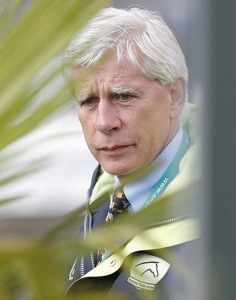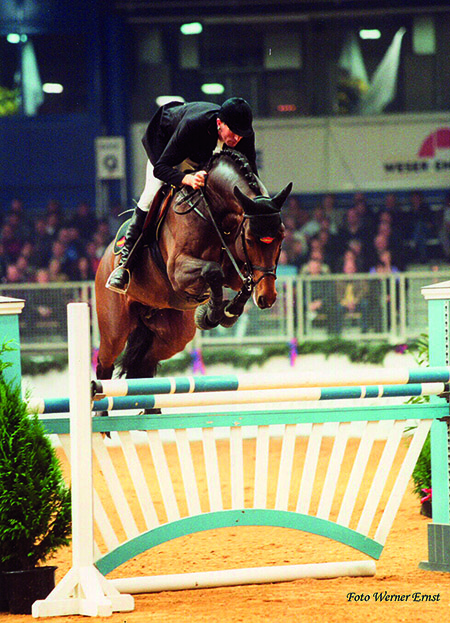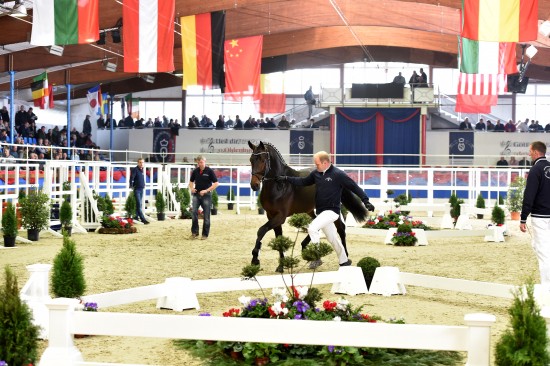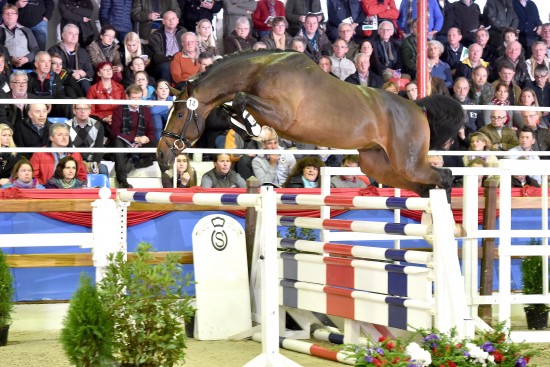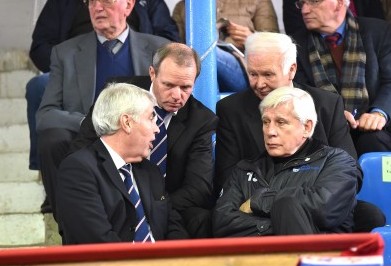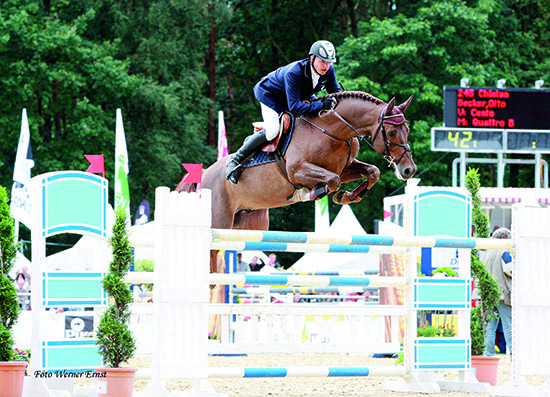The OS Studbook was born in 1997. Initially it was designed to provide a merger between the studbooks of Oldenburg and Zangersheide, but when the final negotiations reached an impasse, the powerful Oldenburg breeder and dealer, Paul Schockemöhle, went ahead with the new studbook anyway.
Probably no single individual has so changed the face of modern showjumping as Paul Schockemöhle. Had he just been a competitor he would have carved himself a place amongst ‘the greats’ but he has done so much more to change the showjumping scene. As a show promoter, as a breeder of horses, as someone who has shown that horses can be a profitable and highly professional business, as a thinker, a leader, and the mover-and-shaker behind a new studbook that aims to breed the showjumping horses of the future – while at the same time guarding some of the grand jumping lines of the past…
Mr Schockemöhle in an interview in 1998 explained the aims of the, then, recently formed Springferdezuchtverband Oldenburg-International:
“We are trying to establish a stud book specifically for breeding showjumpers. In the past twenty years, the aim of most of the breeders, especially in our area, Oldenburg, and Hanover, even in Westfalia, has been to breed a dressage horse. Even at the stallion grading, they are looking for horses that move well, and trot well, because they are always easier to sell when they are young than the showjumpers, and as a result even the good showjumping mares, by Grannus, or Gotthard or Domspatz, these good lines, are being sent to dressage stallions. That in my opinion is the wrong direction – you end up with nothing – half a dressage horse, half a showjumper. That is nothing because we need specialists. I don’t believe we can breed a horse for every discipline. You have to specialise.”
But if you breed only on the basis of jumping ability, don’t you then run the risk that if the horse can’t jump, you then have nothing?
“Okay, we are looking for a modern type, and it is difficult from the Breeding Association to direct everything because we can’t control the mares, but with our stallions we know for sure that they jump very well, that they are good types and they are modern horses. I don’t believe this will be a problem. Okay all the foals may not be Grand Prix jumpers but they will jump.”
Is there any place for conformation evaluation in your breeding association?
“We have a big place for conformation. We look at the horse’s conformation, how they move, how flexible and how elastic they are, especially in canter because all the jumping is done in canter. We pay great attention to conformation and type, but still they have to jump. Okay sometimes you have to make compromises like the Holstein Breeding Association did, they for sure don’t have the same conformation as say the Hanoverians, but look at how many Hanoverians jump at the Bundeschampionate: ten Holstein or Holstein bred horses, to one Hanoverian, because the Holsteiners have been concentrating on jumping and the Hanoverians are concentrating on dressage. Although it is true the Hanoverian Breeding Association is doing more for their jumping horses recently.”
How will stallions become licensed with your new studbook, will they come from licensed stallions in other studbooks or purely on the basis of performance?
“We take stallions that we know are jumping blood which have had good horses, then we have our own stallion gradings twice a year as well . Stallions like Baloubet and Cento, they don’t have to come to us at all, we agree directly that you can breed with them.”
In the long term will the OS be a worldwide studbook like Zangersheide?
“In the long run we think it should be world wide. With the Holstein breeders they have to be purely Holsteiner bred and they are careful not to take outside bloodlines, but we don’t mind if a stallion like Galoubet has trotting blood, if the horse is jumping well, and has good conformation, and has good results, then we take him as a stallion.”
How will mares come into your studbook? Will there be a mare test?
“At the moment we don’t have that, and it is very difficult when we are starting anew and we have to accept forty or fifty older mares. We try to control mainly by the stallions but finally we will probably have some kind of grading for young mares. We work very closely with the Oldenburg Studbook, they take care of the operations – but for example, the committee for our stallion gradings, that is different. Our committee has successful showjumping riders, successful showjumping breeders and so on.”
Initially there was going to be a merger of the OS with the Zangersheide Studbook, that is the only other example of a purely jumping studbook – do you think that Zangersheide has been successful?
“I think so. There are a lot of horses from Zangersheide in international classes but in general we want to be more successful. Zangersheide was made by Mr Melchior, one individual breeder, our stud book will be on very firm ground.”
Will every bloodline be taken into your book?
“We don’t hesitate to breed to any bloodline that will bring us forward in the jumping world.”
How far advanced is the new society?
“We started last year, and I think we have already had 400/500 foals registered this year so I think we are doing quite well.”
You have been involved in breeding showjumping horses for 30 years – has there been a big change in the bloodlines and the type?
“The type is lighter than the Germans had 30 years ago, but in general, I am one who tries to keep the old bloodlines still alive. I think that is very important because even 30 years ago we had very good bloodlines like Gotthard, and we try to keep those lines but just in a lighter way.”
What are the crucial foundation lines?
“I couldn’t say. I wouldn’t mind if they were Dutch, French, German, Holstein, we have no restrictions. We want to help also in a marketing way, that is why we work very closely with Oldenburg. We will use the marketing facilities from Oldenburg. We have already had one foal sale, together with the Oldenburg breeding association, and it was quite successful. Later on we will have three year old sales.”
Emerging as an influential sire in the new studbook, Lord Pezi. He is by the Landgraf son, Lacros out of a mare by Zymbal I by the Anglo Arab, Zeus.
Is it harder with jumping foals? With a dressage foal you can see it move but you can’t see a jumping foal jump?
“No, you can only see a little bit about conformation. You can for sure see how the foal moves, you can’t see it jumping but for that you have to go to the parents. I still buy 100 foals a year.”
And how many of them turn into good jumpers?
“I buy round about 50 foals from dressage lines and 50 foals from jumping lines, and I think I have had quite good success in the last couple of years.”
Do you buy on the basis of blood or conformation?
“Both. You look at the lines and then at the foal.”
Which lines do you look for?
“There’s too many. The French lines, like Baloubet and Quick Star, there are very good Holstein lines – Capitol or Landgraf – there are Hanoverians like Stakkato, so many that even for my own breeding farm I use 25 different stallions.”
Is it hard to find suitable Thoroughbred stallions?
“That’s nearly impossible. We need Thoroughbred blood, but in general you have to breed another generation because the direct Thoroughbreds make very few jumpers. We have not had very good success with them. The very last really top one was Furioso in France. Thoroughbreds are not bred for jumping, they are bred for racing and they are proof of what we are trying to do with our association. They are bred as specialists for running races and they are faster than any other breed because they are bred for that. It is the same when we try to breed jumpers. We can only breed jumpers when we use stallions and mares that are bred for jumping for five, six, seven generations. We always look for some blood – like Baloubet has a Starter mother – we always try to get blood into the horses, but very few direct Thoroughbred progeny were successful.”
You are now breeding quite a few dressage horses, do you prefer breeding jumping horses?
“I have more jumping mares, and I prefer breeding jumpers, but I am not stupid, I am a horseman but a businessman as well, hopefully.”
Will the stallions in your OS studbook do a 100-day test, or a 30-day test, or do you think that is a load of nonsense?
“I believe the 100 day test is stupid. We have already accepted a 30 day test, but later on, if horses want to stay in our stud book they have to prove in the ring with certain results that they are good enough to stay in the stud book.”
One of the big concerns in Warmblood breeding has been the incidence of OCD – is your new studbook going to be rejecting stallions on the grounds that they may have, or be carriers of, OCD?
“We have reached an agreement that we x-ray all the horses and then the stallion grading committee makes the decision that this horse will pass taking into account the x-rays. If you believe there are a few chips but it doesn’t hurt the horse, that shouldn’t be a big problem.”
So breeders are being made aware of stallions that have this problem and they can make the decision for themselves?
“Yes.”
Do you personally see it as a big problem in Warmblood breeding – would you breed to a stallion that didn’t have clean x-rays?
“I breed to stallions which have OCD chips, if I know where they are and how they are sitting, and how big the problem is. I believe that the 95% of the chips is to the benefit of the veterinarian but not to the damage of the horses.”
At the 2007 OS licensing, 13 of the stallions presented were approved. Both the champion and the reserve were sired by Lord Pezi (Lacros / Zymbal I). At the subsequent auction, the 15 stallions sold for a total of €778,000, and Mr Schockemöhle expressed his satisfaction:
“Our Verband which was only founded in 2001, has never had such a good result, but there was no lack of really fabulous jumpers. We will certainly see every one of these stallions again in the sport.”
At the 2013 stallion auction the champion stallion De Quidam (Diarao/Quidam’s Rubin) sold for 115.000 Euro to the stallion station Holkenbrink in Münster. The reserve champion Corydon (Cornado I/Chacco-Blue) was sold to Belgium for 110.000 Euro. The second reserve champion Calcio (Calico/Pilox) was sold for 70.000 Euro. The average price of the licensed OS stallions was 56.692 Euro.
At the Oldenburg licensing in 2014, 34 jumping stallions were presented, 16 received the tick of approval, five were awarded premium. (Photos – Kiki Beelitz)
Champion at the 2014 OS licensing – by Coupe d’Or
The title of Champion stallion was awarded to a son of Coupe d’Or, out of a dam by Stakkato Gold. The young stallion followed in the footsteps of his sire, Coupe d’Or who was Champion stallion in 2012. He was bred by Albert Sprehe and presented by his son, the international showjumper Jan Sprehe.
Silver went to a product of Paul Schockemöhle’s Lewitz Stud, a bay stallion by Action Breaker-Contender-Continue-Pilot. He is closely related to the dam line of Tante, which has already produced a number of international showjumpers and licensed stallions. A son of Casino Berlin out of dam by Contact Me (Landadel), bred and presented by Gerd Sosath, was awarded with Bronze.
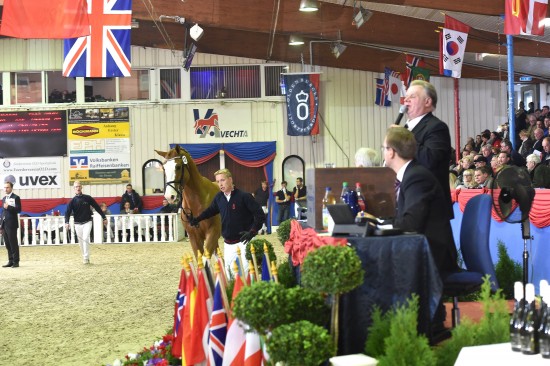
At the 2014 auction, the young stallions were in high demand with overseas buyers, eight out of 13 dressage stallions were sold outside of Germany, ten out of 17 jumping stallions will receive a new passport. Buyers came from China, Great Britain, the Netherlands, Sweden, Denmark, the Bahamas, Finland, India, Italy, Lithuania, Austria and the Czech Republic. The total turnover was 3 Million Euro, with an average price of 129,813 Euro for licensed dressage stallions and 61,909 Euro for licensed jumping stallions.
Chinese clients won the bidding duel for the Jumping Champion and paid 170,000 Euro for the son of Coupe d’Or.
In 2006, 1328 OS foals were born, the following year the figure was slightly higher – 1337. There are currently about 130 OS stallions on the association’s roster.
In 2008, the Springferdezuchtverband Oldenburg-International registered more than 1400 foals in Germany and increasingly more, in neighbouring countries.
In 2013, 1.658 OS foals were born.
Toulago (Toulon/Carthago) won the Weltcup-Qualification 2014 of Zürich with Pius Schwizer, representing OS.
At the Bundeschampionat 2013 OS was thrilled about two champions: Quingai (Quidam de Revel/Cordalmé) and Guido Klatte jun. won the six year old class and Lannaro (Larino/Kannan) with Mandy Goosen took the title of the Bundeschampion of the seven year old horses.
An Update with Paul Schockemöhle:
(based on an interview recorded at Neumünster February 2014)
Background – A history of PSI
The PSI empire began in 1974 when the brothers Alwin, Paul and Werner decided to purchase stallions to stand at their parents’ farm in Mühlen. Breeding has always been a tradition with the Schockemöhle family, father Alois and grandfather Alwin had owned stallions before.
Since both Paul and Alwin were showjumpers, stallions with jumping blood seemed logical. Although Werner was not an active rider, he was a passionate breeder and an official with the Oldenburger Verband for ten years.
The first group of stallions was a mixed lot: the Oldenburger stallion Fanal, the French Anglo-Arab Paladin, the Belgian-bred Granit and the Hanoverian Fürst Ferdinand. Granit (Goldfalk – Flügel van la Roche) had been a top showjumper with Paul Schockemöhle before he was sold to Leon Melchior for the then record sum of one million Deutsch-Mark.
Fürst Ferdinand was selected as a foal by Paul and Werner. He began his career with the Snoek family, then after a stint at Mühlen, he was leased to the State Stud Celle and eventually became one of the foundation sires for Zangersheide in Belgium.
In 1975 Alwin left the partnership, but the stallions Wettstreit (Hanoverian by Wedekind – Fernruf) and Colorado (Anglo-Arab) were added to the ranks.
The Hanoverian stallion Grundstein I (Graphit – Sermon I – Gotthard) was a great success – and an allrounder, siring both dressage and jumping horses, before he was sold to the United States..
Werner was a huge fan of the Gotthard son, Godehard and he covered many mares in his 12 year stint but while the progeny could jump, they were also massive and he disappeared from the breed.
At first the Schockemöhle line up didn’t feature dressage lines, but Paul purchased Sandro in 1985. At first Sandro provided great jumpers, the combination with Gepard mares produced Sao Paulo, Silvio I and II and Sandro Song, the sire of Sandro Hit, and Sandro Hit was to usher in a whole new era of dressage breeding at Mühlen.
Although dressage mares now account for most of the visitors, Paul Schockemöhle’s first love remains jumping. He founded the Springpferdezuchtverband Oldenburg-International (OS) and has been its chairman ever since. I caught up with him at Neumünster, the show he runs with his partner, Ulli Kasselmann, for this interview:
When I interviewed you in 1998, the Oldenburg jumping book was only 12 months old – have you been happy with the way it has developed in 16 years…
“I think we are already the fourth or fifth biggest studbook in Germany. You know breeding takes a long time, from covering a mare to competing in a Grand Prix in Aachen, but our studbook has already produced some Grand Prix horses and international horses.”
“I think it was an important step, to found our studbook, because the breeders, especially the breeders in Oldenburg, were trying to breed dressage horses with mares with jumping lines and they were mixing everything up. I think if you want to be successful, then you have to really specialize, with the right breeding lines for dressage, and the right lines for jumping.”
Chintan (Cento / Quattro B) with Otto Becker, the OS brand in action…
“I think the Oldenburg studbook is now in a very good situation. The results are improving, in dressage as well as jumping, and the two studbooks, they are not merged, but we handle it equally, we have a head committee of four people, two from the dressage studbook, and two from the jumping studbook. The Oldenburg studbook has had so much success because of the stallion owners – you can’t change all the mares – but the stallions normally decide the fate of a studbook. The stallions are owned privately and they are in competition with each other, and that produces very good stallions.”
But the amazing thing is that since we talked last, many of those great Oldenburg stallion stations have disappeared, Vorwerk, Seiffert, Kathmann, Gronwöhldhof… really there is only Sosath and yourself remaining…
“Sprehe also, but like I said, it is a big competition between the stallion owners. Okay in general, we are friends, but in the business we are competitors and that always finally brings better results. That is a big advantage against government owned studbooks.”
But is it a worry that some of the great old stallion stations are dead?
“There are coming new ones as well, everything that is private and subject to competition will change with time. That is normal. Unluckily some breeding stations disappeared but probably they didn’t have modern enough stallions.”
All over Europe the breeders are saying that the number of mares being bred is down, maybe 50%, is this happening to you?
“Not so much, at my station probably the decrease is not bigger than 5% because we really try to get connections with other breeding stations all over Europe – I have connections to Holland, Joep van Uytert, we have connections to Denmark with Blue Hors and Helgstrand. I have some stallions together with the family Linsenhoff, and all this makes it possible to have the stallions that we have.”
Which stallions do you see as the stars of jumping breeding at the moment?
“Difficult to say. If you look at the start lists at any big show, there are a lot of stallions making top horses. It is not like fifteen or twenty years ago when you had an outstanding stallion like Landgraf, who was absolutely the star in Holstein and all over Germany. Now we have quite a lot of different lines which are producing good horses. At the moment, the star in Westfalia is Cornet Obolensky, the star in Hanover is Stakkato, the star in Holstein… there were three or four, Landgraf, Cassini, Lord and so on, and now there are sons of them, Caretino was one of them, and Casall is for sure the most popular stallion in Holstein.”
Will Diarado compete in Grand Prix competition?
“I hope so, at the moment it looks like that. Last week and the week before, we had our stallion presentations and he really jumped very well. He did his first S classes last year and in every class he jumped, he was great.”
How important is French blood in your program?
“To work with French blood is quite important, in Oldenburg and Holstein as well, they really used Cor de la Bryère quite a lot to refine the horses. In general you have to be careful with the French horse, they are a little bit less good to ride than most of the German horses, but they are very brave, they are not spooky, that helps quite a lot. Diamant de Sémilly, the father of Diarado, has been very successful himself in the sport, and number one in France, so it is good to have a stallion here from his bloodline.”
How important is it that the stallion has a Grand Prix career?
“It is the way of the future. A lot of government owned stallions weren’t shown, they were just used for breeding, but those days are over. You see it more and more, in France, in Holland, in Belgium, they show the stallions, they compete, and these stallions will be used by the breeders – no doubt.”
Do you see a day when there will just be one German studbook?
“Okay between the studbooks there are very different structures. I know there is a lot of talk about the German Warmblood horse, but I think that will take quite a lot of time before the studbooks unify and make one studbook, because of the structures. We talk about that in Oldenburg, and the people there think it is good that we are independent.’
But some people say that your stables in Mühlen are in fact the national stud of the German horse…
“That’s not right. Okay we have a lot of stallions, luckily I have some breeders, but we are not the only one, and like I said, we have competition.”
Is it becoming to easy in the day of the internet, and beautiful looking brochures, to ‘manufacture’ a stallion?
“No, I think today you order fresh semen from anywhere in Europe and I think that is good for the breeding of horses, especially the breeders who really take care which stallion is the right one for his own mare. The breeder who really thinks about it, not just going to the nearest station and taking a stallion from there. The times of just going next door are over, and they are the breeders who didn’t get any money for their foals and they are the people who are finished with breeding. Now there are breeders who are much more educated, they know much more about the horses. They are using the internet and youtube to see the stallions all around Europe to see where they are investing and that helps a lot.”


